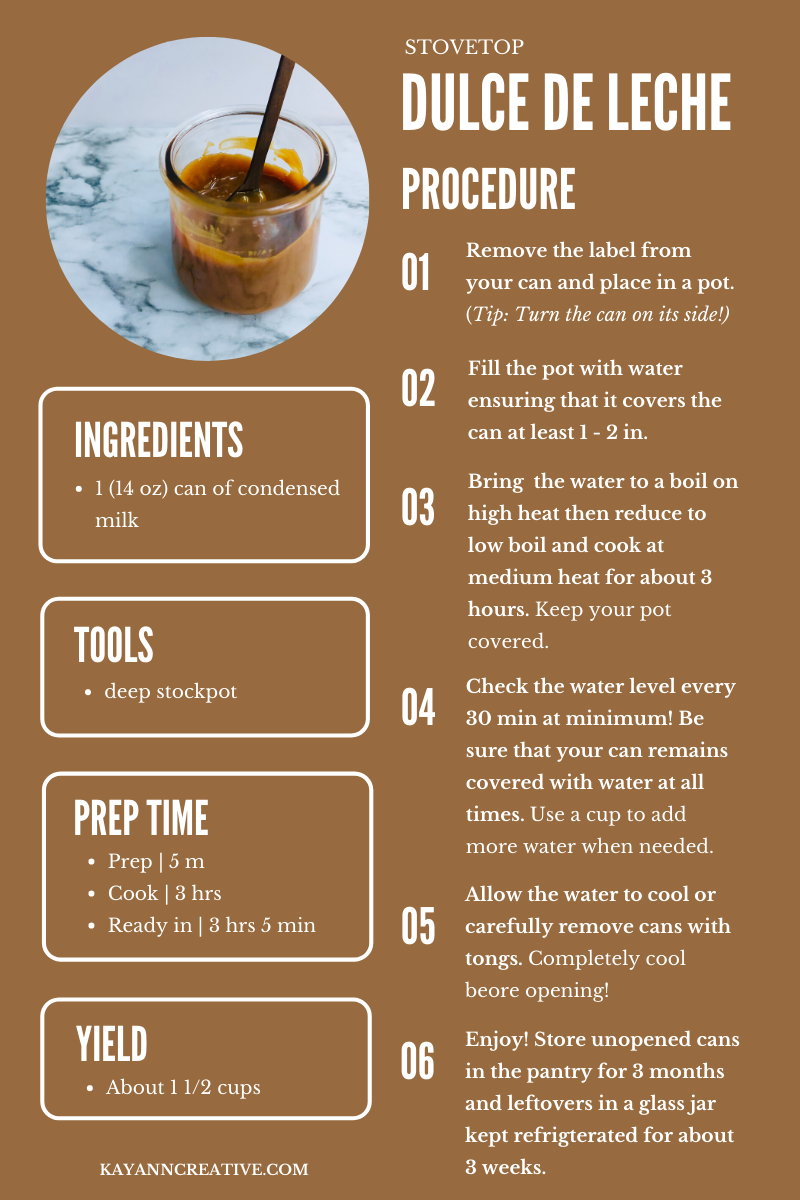Dulce De Leche
Dulce De Leche
delicious, caramel-like sweet treat of South American origin.
Hello, all! Kay here with an amazing sweet treat that you’ll want to put on everything.
First off, I hope you are all safe and well in these uncertain times. Ann and I are still doing our part to remain safe and distant. I’ve read a lot of articles lately that suggest home baking is on the rise as we all attempt to find ways to remain occupied and positive. This makes sharing recipes a very special pleasure right now.
So what is “dulce de leche?”
Literally translated from Spanish, it means “milk jam” or “candy of milk.” (I’ve also heard other translations like “sweet milk.”) Dulce de leche is a delicious caramel-like sweet treat used in many South American confections. There are many variations of dulce de leche, having different textures and using different kinds of milk and spices.
In my opinion dulce de leche has more depth, no bitterness, and is less sweet than traditional caramel. It is more comparable to toffee or butterscotch.
Is dulce de leche the same as caramel?
No, they are not the same. More like really good friends or close family. Caramel is sugar-based and dulce de leche is milk-based.
Caramel is made by quickly heating sugar until brown then adding butter and milk. (Perhaps a more in-depth caramel convo in a future blog post?)
Dulce de leche is traditionally made by combining milk and sugar, (and sometimes spices depending upon the region), then slowly cooking until brown. This process is also known as the Maillard reaction. Honestly the science of this is a little difficult for me to explain, and I wouldn’t be the best to do so anyway. But the Maillard reaction occurs in the cooking of savory foods foods as well: burgers, beer, and even steaks. It’s information worth knowing. If you want a more in-depth introduction to the ins-and-outs of the Maillard reaction, and how it’s different than caramelization, I really like this article.
This recipe will get you a delicious dulce de leche and requires less skill than starting from scratch.
(There are other “quick” ways to make dulce de leche: crockpot, instant pot, even in the oven. I personally prefer this stovetop version.)
All you need is condensed milk and a large stockpot for this method. (Feel free to make 3 - 4 cans at once if you have the room!) The bigger the better for the pot because you will need to refill the water little or not at all. A good trick is to turn your unopened can on its side for a height adjustment.
For this recipe I heated my unopened can of condensed milk for three hours. Feel free to adjust the time according to how light or dark you want your sauce. If you don’t trust yourself to guesstimate your timing variation, transfer the condensed milk to a very tightly-sealed mason jar and continue the recipe. Now you can see it brown! Use tongs to carefully remove and check when needed. Be sure to keep your cans upright if you use this alternative.
DO NOT forget to check the water level: Yes, it is that serious.
I can’t stress this enough. Check your water level and ensure that your cans remain covered with water for the ENTIRE cooking process.
The pressurized cans will explode if left unattended wtih a low water level. (I have seen the effects of an exploded dulce de leche attempt, and the end result was a kitchen remodel.)
Not trying to dramatize your dulce de leche making experience, but this is so important it needed to be in bold (lol.)
I check mine about every 20 minutes due to habit, but you can check it at least every 30 minutes. If you have a large enough pot you can ensure a higher water level, which means little to no water refills.
Another important tip. Be sure to allow your cans to cool completely before opening or there will most defintely be a splattered mess.
That’s basically all there is to it! You can store unopened cans of your finished dulce de leche in the cabinet for up to three months. As long as you don’t open it, there’s no need to refrigerate your sauce. After opening, store the leftover dulce de leche in the refrigerator in a tightly-sealed glass jar for up to three weeks. (Mine never lasts that long.)
Rememeber that when cooled, dulce de leche develops a pudding-like consistencey. (No judgement if you just eat it like this straight from the jar with a big spoon.)
If you want if to be pourable, you will need to use it while warm or heat it using a double boiler. If you reheat it too quickly in the microwave it can easily burn, so be sure to use the defrost setting. You can also add a little cream or milk to make the dulce de leche more pourable for toppings.
Some of the ways that I use dulce de leche include . . .
Coffee (one of my favorite ways to use it)
Ice cream topping
Cake frosting
French toast drizzzle
Doughnut filling
The possibilities for dulce de leche are endless and I am still finding interesting ways to incorporate it in my recipes.
Wishing you all love and positivety,
Bake away!
- Kay



